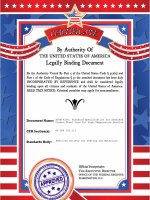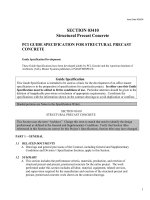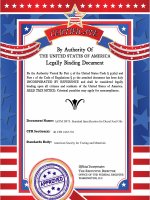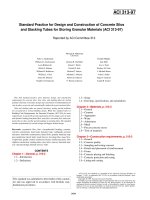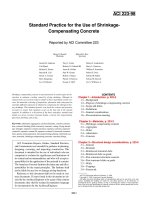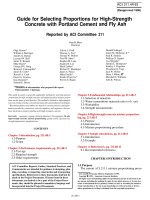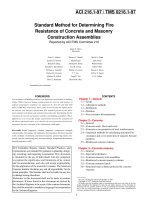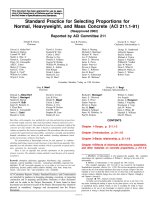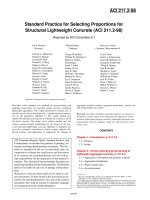standard specification for repairing concrete with epoxy mortars (aci 503.4-92, reapproved 1997, 2003)
Bạn đang xem bản rút gọn của tài liệu. Xem và tải ngay bản đầy đủ của tài liệu tại đây (50.13 KB, 5 trang )
Standard Specification for Repairing Concrete
with Epoxy Mortars
(ACI 503.4-92,
Reapproved 1997, 2003)
Reported by ACI Committee 503
R.W. Gaul
George
Selden
Chairman
Secretary
Russell H. Brink
George
Horeczko
Harold
C.
Klassen
Joseph
A. McElroy
Committee voting on the 1992 revisions:
Raymond J.
Schutz
Chairman
Milton D. Anderson
Roger W. Black
John P. Cook
Floyd E.
Dimmick
Wolfgang D.
Eisenhut
Jack J.
Fontana
Robert W. Gaul
Paul R. Hollenbach
Leonard J. Mitchell
Myles A. Murray
Leonard Pepper
David P. Hu
T. Michael Jackson
Troy D. Madeley
Albert Mayer
Joseph A. McElroy
Paul F.
McHale
Peter
Mendis
This
specification
describes
the
work of repairing
defects
in hardened
portland cement concrete with a sand-filled mortar using an adhesive
binder such as
defined
in ASTM C 881. It
includes
controls for adhesive
labeling
storage,
handling,
mixing and application, surface evaluation and
preparation
as
well as inspection and quality control.
Keywords:
bond (concrete to concrete); concrete construction;
epoxy
resins,
hardened concrete;
mortars
(material); quality control; repairs;
resurfacing; specifications; standards.
FOREWORD
This
foreword
is
included for explanatory purposes only; it
does not form a part of Standard Specification ACI 503.4.
Standard Specification 503.2 is a reference standard
which the Architect/Engineer may cite in the project
speci-
ACI
Committee Reports, Guides, Standard Practices, and
Commentaries are intended for guidance in designing, plan-
ning, executing, or inspecting construction and in preparing
specifications. References to these documents shall not be
made in the Project Documents. If items found in these
documents are desired to be a part of the Project Docu-
ments, they should be phrased in mandatory language and
incorporated into the Project Documents.
G.M.
Scales
Raymond J.
Schulz
George W. Whitesides
Myles A. Murray
Secretary
Richard Montani
Joseph M. Plecnik
Hamid
Saadatmanesh
W. Glenn Smoak
Joe Solomon
Michael
M.
Sprinkel
Douglas
G.
Walters
fication(s) for any building project, together with sup-
plementary requirements for the specific project.
This specification is written in the section and three-part
format of the Construction Specifications Institute, but with
the numbering system modified to ACI requirements. The
language is generally imperative and terse.
A specification guide and checklist are included as a
preface to, but not forming a part
of
Standard Specifi-
cation
ACI
503.4. The purpose of this guide and checklist
is to assist the Architect/Engineers' designer(s) and
specifier(s) to properly choose and
specify
the necessary
supplementary requirements for the project specification(s).
*
Adopted
as
a
standard of the American Concrete Institute effective
June
1979.
in accordance with the Institute’s standardization procedure. It
was revised
according to the expedited procedure effective October 1986 and March 1992,.
Copyright
8
1978 and 1986 American
Concrete
Institute.
All
rights reserved including rights of reproduction and use
in any form or by
any means. including the making of copies by any photo
process,
or by any elec-
t
ronic or
mechanical
device. printed or written or
oral,
or recording for sound or
visual reproduction or for use in anv
knowledge
or retrieval
system or
device,
unless permission in writing is obtained from the copyright
proprietors.
503.4-l
503.4-2
CONTENTS
SPECIFICATION GUIDE
Specification guide, pg. 503.4-2
Specification checklist, pg.
503.4-2
Section
l-General
requirements, pg.
503.4-4
SGl-Standard
Specification
ACI
503.4 is intended to
be used essentially in its entirety, by citation in the
project specification, to cover all usual requirements for
repairing concrete with epoxy mortars. Individual sec-
tions, parts, and articles should not be copied into project
specifications since taking them out of context may
change their meanings.
1.1-Scope
1.2-Notation
1.3 Specification wording
1.
4-Reference
standards
Section 2-Materials and application, pg. 503.4-4
Part
2.1-General,
pg.
503.4-4
2.1.1-Description
2.1.2-Submittals
2.1.3-Quality
assurance
2.1.4-Product
delivery, storage, and handling
2.1.5-Project conditions
SG2-However,
adjustments to the needs of a parti-
cular project shall be made by the Architect/Engineer’s
designers and specifiers by reviewing each of the items
indicated in this specification guide and checklist and
then including their decisions on each as mandatory
requirements in the project specification.
SG3-These
mandatory requirements shall designate
specific qualities, procedures, materials, and performance
criteria for which alternatives are permitted or for which
provision is not made in Standard Specification
ACI
503.4. Or exceptions shall be taken in Standard Speci-
fication
ACI
503.4 if required.
SG4-A
statement such as the following will serve to
make Standard Specification ACI 503.4 an official part of
the contract requirements:
Part 2.2-Products, pg.
503.4-4
2.2.1-Epoxy
mortar
Repairing concrete with epoxy mortars shall conform
to all requirements of “Standard Specification for
Repairing Concrete with Epoxy Mortars
(ACI
503.4),”
published by the American Concrete Institute, De-
troit,
Mich.,
except as modified by the requirements
of this project specification.
Part 2.3-Execution, pg.
503.4-4
2.3.1-Preparation
of concrete surfaces
2.3.2-Inspection
of concrete surfaces prior to mortar
application
2.3.3-Mortar
mixes
2.3.4-Mortar application
2.3.5-Cleanup
2.3.6-Safety
SG5-The
specification checklist that follows is ad-
dressed to each item of
ACI
503.4 that requires the
designer/specifier to make a choice where alternates are
indicated, or to add provisions where they are not in-
dicated in
ACI
503.4, or to take exceptions to ACI 503.4.
The checklist consists of one column identifying sections,
parts, and articles of
ACI
503.4, and a second column of
notes to the designer/specifier to indicate the action
required of them.
SPECIFICATION CHECKLIST
Section/Part/Article of
ACI
503.4 Notes to the Designer/Specifier
Section
l-General
requirements
1.1 Scope
1.4 Reference standards
Section 2-Materials and application
2.1.2 Submittals
Indicate specific scope.
Review applicability of cited references and take ex-
ceptions if required.
To whom sent?
EPOXY RESINS
503.4-3
SPECIFICATION CHECKLIST (cont.)
Section/Part/Article of
ACI
503.4
2.1.3.2
Application control
2.1.4.2
Storage of materials
2.1.5.1 Environmental requirements
2.2.1 Epoxy mortar
2.3.1 Preparation of surfaces
2.3.2 Inspection of surfaces
2.3.2.2 Pullout strength tests
2.3.2.4 Surface condition of concrete
Notes to the Designer/Specifier
Mixing and application procedures submitted must be
in accordance with product manufacturer’s instructions.
Storing epoxy compounds at other than specified tem-
perature range may result in degradation of the pro-
duct. If such storage takes place, manufacturer should
be contacted before product is used.
Performance of epoxy systems may be affected by tem-
perature, humidity, and surface water. Strict adherence
to the manufacturer’s recommendations should be
maintained. Where other unusual conditions are en-
countered, the material manufacturer should be con-
sulted before application.
Epoxy mortars consist of a two component epoxy sys-
tem plus aggregate which may or may not be incorpor-
ated in one or both components. Since the amount and
type of aggregate is important to the performance of
the mortar, the supplier and contractor must be in full
agreement on selection and use. If the aggregate is
furnished with proper instructions by the supplier the
problem is minimized.
The amount and type of aggregate selected can re-
sult in a mortar mix that will not adequately wet the
concrete substrate and thus can result in a poor bond.
The manufacturers’ recommendations should be close-
ly followed regarding the need for and application of a
primer for the mortar mix selected.
Specify limitations, if any, on use of mechanical
abrasion, and on disposal of waste products.
Specify if architect/engineer will also inspect, and if
hold points are required.
The test method specifies the bonding of a steel pipe
cap to the concrete surface with an epoxy adhesive. If
the test results not in failure of the concrete but in
cohesion of the epoxy resin adhesive or any failure in
adhesion, the test shall be repeated. Repeated failures
in adhesion, or cohesion in the adhesive, indicate im-
proper cleaning of the concrete, incorrect adhesive, or
faulty adhesive application techniques.
Surface condition of the concrete must be in accor-
dance with the suppliers’ recommendation. Some
mortars require a dry surface and a test method should
be available to the applicator.
Some epoxy adhesives may be capable of
wetting
the concrete surface at temperatures below
40
F.
The
specification should allow such use only if test data is
available which conclusively demonstrates
adequate
bond at the actual concrete temperature expected.
503.4-4 ACI STANDARD
SPECIFICATION CHECKLIST (cont.)
Section/Part/Article of
ACI
503.4
I
Notes to the Designer/Specifier
2.3.4.1
Mortar application
SECTION l-GENERAL REQUIREMENTS
l.l-Scope
1.1.1 This
standard specification covers repairing of
defects in hardened portland cement concrete with
sand-
fiied epoxy mortar.
1.1.2
The
provisions of this standard specification shall
govern unless otherwise specified in the contract docu-
ments. In case of conflicting requirements, the contract
documents shall govern.
1.2-Notation
1.2.1 ACI:
American Concrete
P.O.
Box 19150
Detroit, MI 48219
Institute
1.2.2
ASTM:
American Society for Testing and
Materials
1916 Race Street
Philadelphia, PA 19103
1.3-Specification
wording
1.3.1 The language of this standard specification is
generally imperative and terse, and may include incom-
plete sentences. Omissions of phrases and of words such
as “the contractor shall,” “in accordance with,” “shall be,”
“as indicated,” “a,” “an,
”
“the,” “all,” etc., are intentional.
Omitted phrases and words shall be supplied by in-
ference.
1.4-Reference
standards
1.4.1 The standards referred to in this Standard Speci-
fication
ACI
503.4 are listed in Article 1.5.2 of this
section, with their complete designation and title in-
cluding the year of adoption or revision and are declared
to be a part of this Standard Specification
ACI
503.4 the
same as if fully set forth herein, unless otherwise in-
dicated in the contract documents.
1.4.2 ASTM standard
C 881-87
Standard Specification for Epoxy-Resin-Base
Bonding Systems for Concrete
SECTION 2-MATERIALS AND APPLICATION
Part
2.1-General
Too thin an application of epoxy mortar can result in a
surface without adequate integrity for intended use.
Too thick an application can result in delamination
caused by temperature changes. See “Use of Epoxy
Compounds with Concrete” reported by Committee 503
for a more complete explanation.
2.1.1 Description
-This section covers the require-
ments for surface preparation of hardened concrete and
for materials and application of the epoxy mortar.
2.1.2
Submittals
2.1.2.1 Contractor shall submit manufacturer’s
certification verifying conformance to material specifi-
cations specified in Part 2.2.
2.1.3
Quality assurance
2.1.3.1
Labeling-Clearly mark all containers with
the following information:
a)
Name of manufacturer
b)
Manufacturer’s product identification
c)
Manufacturer’s instructions for mixing
d)
Warning for handling and toxicity
2.1.3.2
Application control-Submit mixing and
application procedures for approval prior to use.
2.1.4 Product delivery, storage, and handling
2.1.4.1 Delivery of
materials-Deliver
all materials
in sealed containers with labels legible and intact.
2.1.4.2 Storage of materials
-Store all materials
at
temperatures between 40-100 F (5-38 C) unless otherwise
recommended by manufacturer.
2.1.4.3 Handling of materials Handle all materials
in a safe manner and in a way to avoid breaking con-
tainer seals.
2.1.5 Project conditions
2.1.5.1 Environmental requirements-Contractor
shall comply with manufacturer’s recommendations as to
environmental conditions under which the epoxy com-
pound may be applied.
Part 2.2-Products
2.2.1 Epoxy mortar-ASTM C 881
Type III. Curing
temperature requirements (Class) and viscosity (Grade),
as well as special requirements regarding filling of either
the components or the final system, shall be determined
by supplier and contractor after project conditions have
been established.
Part 2.3-Execution
2.3.1 Preparation of concrete
surfaces
2.3.1.1 Concrete surfaces to which epoxies are to be
applied shall be newly exposed parent concrete free of
loose and unsound materials. Prepare surfaces by
mech-
EPOXY RESINS
503.4-5
anical
abrasion.
2.3.1.3 Mechanical abrasion-Use sandblasting,
scarifying, waterblasting, or other approved means.
2.3.2
Inspection of concrete surfaces prior to mortar ap-
plication
2.3.2.1 Inspect all concrete surfaces prior to
application of mortar to insure that requirements of this
Article
2.3.2
are met.
2.3.2.2 Surfaces shall be sound concrete which
exhibits
a minimum 100 psi pullout strength when tested
in accordance with Appendix A of “Use of Epoxy Com-
pounds with Concrete,” reported by
ACI
Committee 503.
2.3.2.3 Surfaces shall be free of any deleterious
materials such as laitance, curing compounds, dust, dirt,
and oil. Materials resulting from surface preparation spe-
cified in Article 2.3.1 shall be removed.
2.3.2.4 All concrete surfaces shall be dry as defined
in Article 2.3.2.5 below unless a water-insensitive coating
is used. Surface temperature shall be at least 40 F to per-
mit wetting of concrete surface by epoxy coating.
2.3.2.5 Evaluate moisture content for concrete by
determining if moisture will collect at bond lines between
old concrete and epoxy coating before epoxy has cured.
This may be accomplished by taping a 4 x 4 ft poly-
ethylene sheet to concrete surface. If moisture collects on
underside of polyethylene sheet before epoxy would cure,
then allow concrete to dry sufficiently to prevent the
possibility of moisture between old concrete and new
epoxy.
2.3.3
Mortar mixes
2.3.3.1 Mix epoxy components in a clean container
free of harmful residue or foreign particles.
2.3.3.2 Condition epoxy compound components to
be at a temperature between 60-100 F (16-38 C), unless
otherwise recommended by manufacturer.
2.3.3.3 Thoroughly blend epoxy components with a
mechanical mixer to a uniform and homogeneous mix-
ture. Mix small batches (up to 1 qt) by use of spatulas,
palette knives, or similar devices.
2.3.4
Mortar application
2.3.4.1
Apply epoxy mortar to concrete surface by
trowel or
screed.
Thickness shall be within the limits re-
commended by the manufacturer.
2.3.4.2 Work mortar into place and consolidate tho-
roughly so that all contact surfaces are wet by the mortar
and entrained air is reduced to the level recommended
by manufacturer.
2.3.4.3 Finish surface of mortar to texture, color,
and smoothness required for the specific application.
2.3.4.4 Upon completion of finishing operations,
allow mortar to cure in accordance with manufacturer’s
recommendations.
2.3.5
Cleanup
2.3.5.1 Protect concrete surfaces, beyond limits of
surface receiving mortar, against spillage.
2.3.5.2 Immediately remove any epoxy compound
applied or spilled beyond desired areas. Perform cleanup
with material designated by epoxy mortar manufacturer.
Avoid contamination of work area.
2.3.6 Safely-Epoxy materials may be skin irritants or
sensitizers to many people. Accordingly, advise appli-
cators to avoid contact with eyes and skin, inhalation of
vapors, and ingestion. Make protective and safety equip-
ment available on site. Heed all label warnings by manu-
facturer. Make application in accordance with applicable
safety laws.
